Leading and Managing Organisational Resources: MBA Report
VerifiedAdded on 2020/10/05
|15
|4839
|248
Report
AI Summary
This report provides an in-depth analysis of organisational ambidexterity within the context of MBA (Match Box Architects), focusing on how the integration of operations, leadership, information systems, and finance impacts efficiency and performance. The report explores the concepts of exploitation and exploration structures, advocating for a balanced approach to achieve optimal results. It emphasizes the importance of adapting to changing market demands and recommends architectural design improvements, including the utilization of unused spaces and the integration of human, social, and organizational capital. The analysis covers various angles of ambidexterity, its relationship with organisational performance, and the role of integrated functions and competencies in achieving desired outcomes. The report highlights the need for firms to align their strategies with structures and to foster a culture of continuous learning and adaptation to maintain a competitive edge.
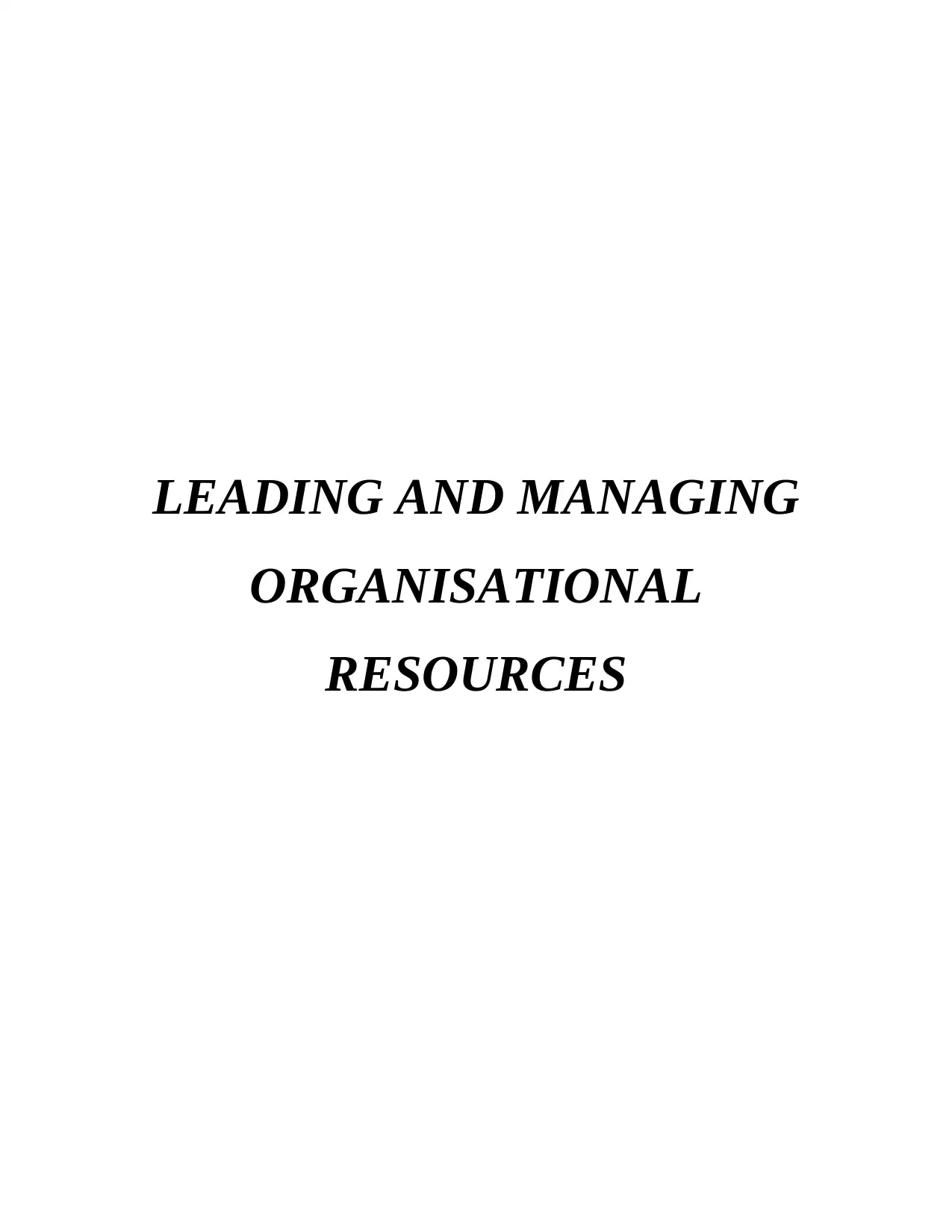
LEADING AND MANAGING
ORGANISATIONAL
RESOURCES
ORGANISATIONAL
RESOURCES
Paraphrase This Document
Need a fresh take? Get an instant paraphrase of this document with our AI Paraphraser
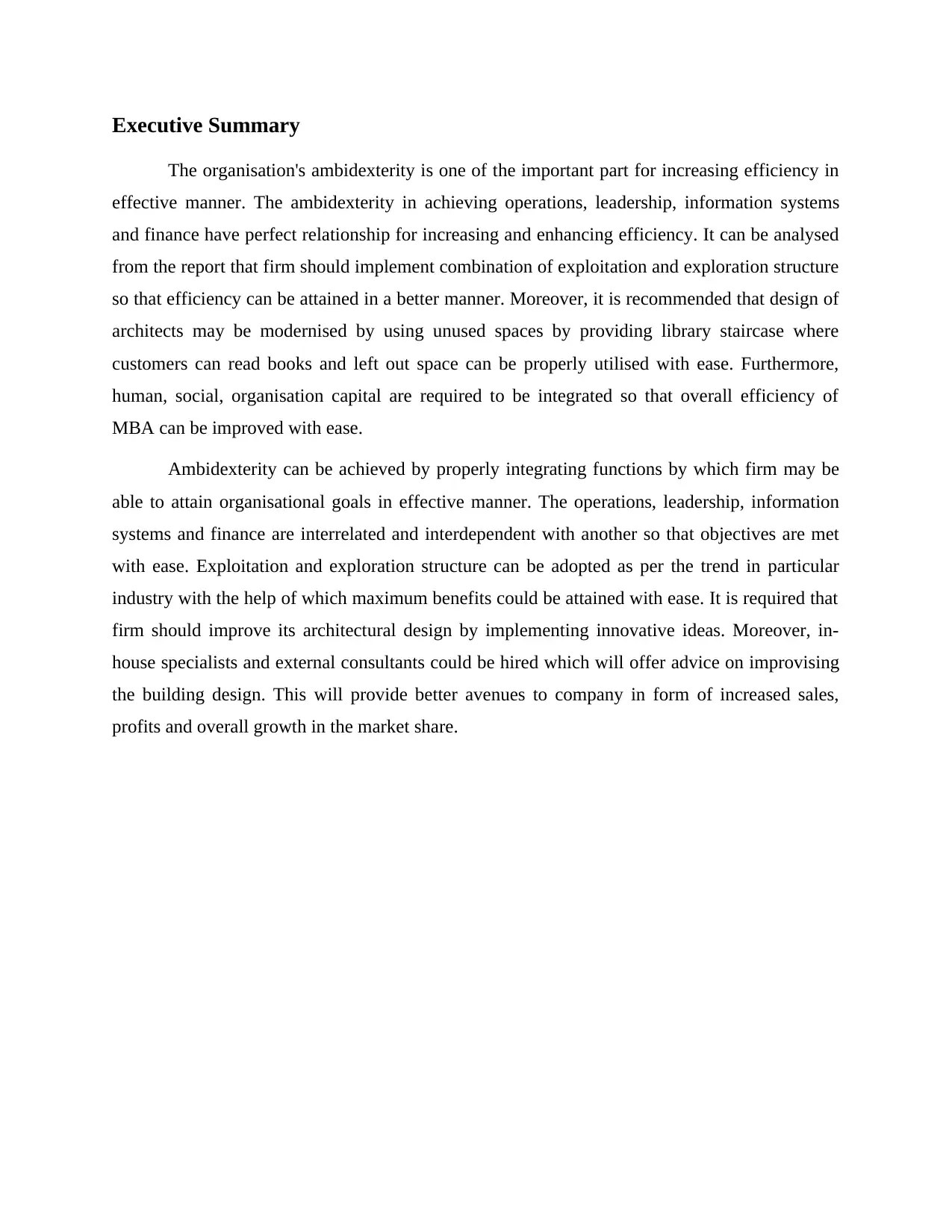
Executive Summary
The organisation's ambidexterity is one of the important part for increasing efficiency in
effective manner. The ambidexterity in achieving operations, leadership, information systems
and finance have perfect relationship for increasing and enhancing efficiency. It can be analysed
from the report that firm should implement combination of exploitation and exploration structure
so that efficiency can be attained in a better manner. Moreover, it is recommended that design of
architects may be modernised by using unused spaces by providing library staircase where
customers can read books and left out space can be properly utilised with ease. Furthermore,
human, social, organisation capital are required to be integrated so that overall efficiency of
MBA can be improved with ease.
Ambidexterity can be achieved by properly integrating functions by which firm may be
able to attain organisational goals in effective manner. The operations, leadership, information
systems and finance are interrelated and interdependent with another so that objectives are met
with ease. Exploitation and exploration structure can be adopted as per the trend in particular
industry with the help of which maximum benefits could be attained with ease. It is required that
firm should improve its architectural design by implementing innovative ideas. Moreover, in-
house specialists and external consultants could be hired which will offer advice on improvising
the building design. This will provide better avenues to company in form of increased sales,
profits and overall growth in the market share.
The organisation's ambidexterity is one of the important part for increasing efficiency in
effective manner. The ambidexterity in achieving operations, leadership, information systems
and finance have perfect relationship for increasing and enhancing efficiency. It can be analysed
from the report that firm should implement combination of exploitation and exploration structure
so that efficiency can be attained in a better manner. Moreover, it is recommended that design of
architects may be modernised by using unused spaces by providing library staircase where
customers can read books and left out space can be properly utilised with ease. Furthermore,
human, social, organisation capital are required to be integrated so that overall efficiency of
MBA can be improved with ease.
Ambidexterity can be achieved by properly integrating functions by which firm may be
able to attain organisational goals in effective manner. The operations, leadership, information
systems and finance are interrelated and interdependent with another so that objectives are met
with ease. Exploitation and exploration structure can be adopted as per the trend in particular
industry with the help of which maximum benefits could be attained with ease. It is required that
firm should improve its architectural design by implementing innovative ideas. Moreover, in-
house specialists and external consultants could be hired which will offer advice on improvising
the building design. This will provide better avenues to company in form of increased sales,
profits and overall growth in the market share.
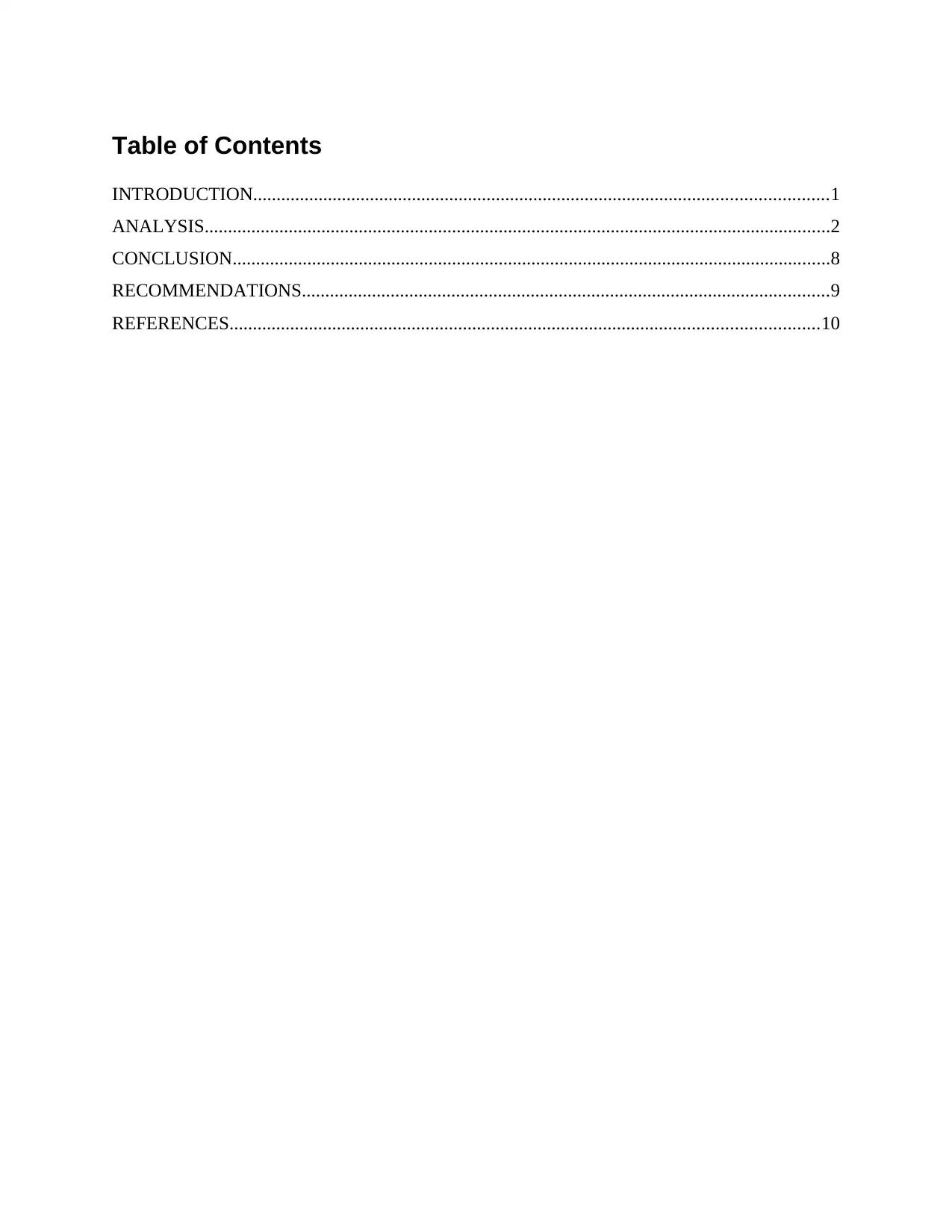
Table of Contents
INTRODUCTION...........................................................................................................................1
ANALYSIS......................................................................................................................................2
CONCLUSION................................................................................................................................8
RECOMMENDATIONS.................................................................................................................9
REFERENCES..............................................................................................................................10
INTRODUCTION...........................................................................................................................1
ANALYSIS......................................................................................................................................2
CONCLUSION................................................................................................................................8
RECOMMENDATIONS.................................................................................................................9
REFERENCES..............................................................................................................................10
⊘ This is a preview!⊘
Do you want full access?
Subscribe today to unlock all pages.

Trusted by 1+ million students worldwide
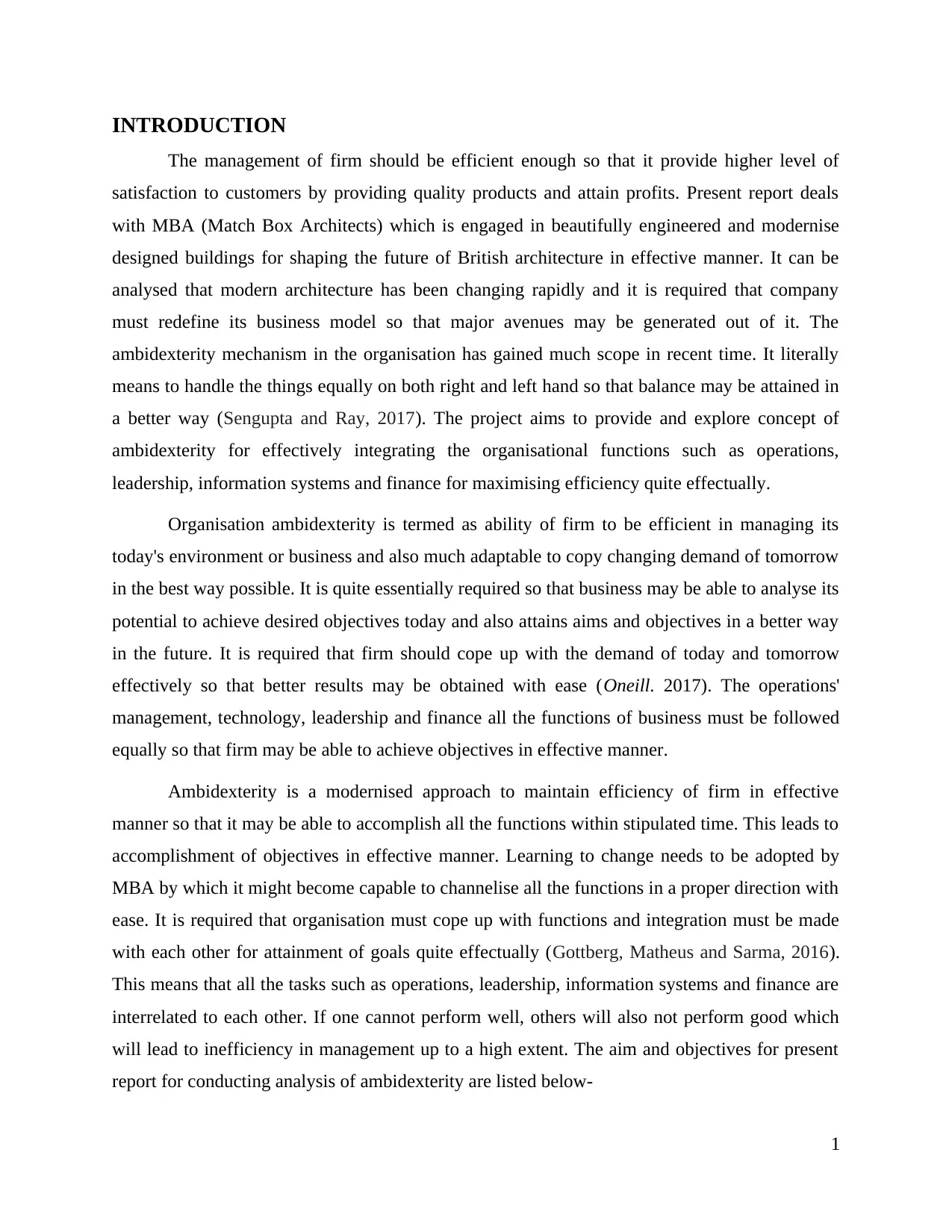
INTRODUCTION
The management of firm should be efficient enough so that it provide higher level of
satisfaction to customers by providing quality products and attain profits. Present report deals
with MBA (Match Box Architects) which is engaged in beautifully engineered and modernise
designed buildings for shaping the future of British architecture in effective manner. It can be
analysed that modern architecture has been changing rapidly and it is required that company
must redefine its business model so that major avenues may be generated out of it. The
ambidexterity mechanism in the organisation has gained much scope in recent time. It literally
means to handle the things equally on both right and left hand so that balance may be attained in
a better way (Sengupta and Ray, 2017). The project aims to provide and explore concept of
ambidexterity for effectively integrating the organisational functions such as operations,
leadership, information systems and finance for maximising efficiency quite effectually.
Organisation ambidexterity is termed as ability of firm to be efficient in managing its
today's environment or business and also much adaptable to copy changing demand of tomorrow
in the best way possible. It is quite essentially required so that business may be able to analyse its
potential to achieve desired objectives today and also attains aims and objectives in a better way
in the future. It is required that firm should cope up with the demand of today and tomorrow
effectively so that better results may be obtained with ease (Oneill. 2017). The operations'
management, technology, leadership and finance all the functions of business must be followed
equally so that firm may be able to achieve objectives in effective manner.
Ambidexterity is a modernised approach to maintain efficiency of firm in effective
manner so that it may be able to accomplish all the functions within stipulated time. This leads to
accomplishment of objectives in effective manner. Learning to change needs to be adopted by
MBA by which it might become capable to channelise all the functions in a proper direction with
ease. It is required that organisation must cope up with functions and integration must be made
with each other for attainment of goals quite effectually (Gottberg, Matheus and Sarma, 2016).
This means that all the tasks such as operations, leadership, information systems and finance are
interrelated to each other. If one cannot perform well, others will also not perform good which
will lead to inefficiency in management up to a high extent. The aim and objectives for present
report for conducting analysis of ambidexterity are listed below-
1
The management of firm should be efficient enough so that it provide higher level of
satisfaction to customers by providing quality products and attain profits. Present report deals
with MBA (Match Box Architects) which is engaged in beautifully engineered and modernise
designed buildings for shaping the future of British architecture in effective manner. It can be
analysed that modern architecture has been changing rapidly and it is required that company
must redefine its business model so that major avenues may be generated out of it. The
ambidexterity mechanism in the organisation has gained much scope in recent time. It literally
means to handle the things equally on both right and left hand so that balance may be attained in
a better way (Sengupta and Ray, 2017). The project aims to provide and explore concept of
ambidexterity for effectively integrating the organisational functions such as operations,
leadership, information systems and finance for maximising efficiency quite effectually.
Organisation ambidexterity is termed as ability of firm to be efficient in managing its
today's environment or business and also much adaptable to copy changing demand of tomorrow
in the best way possible. It is quite essentially required so that business may be able to analyse its
potential to achieve desired objectives today and also attains aims and objectives in a better way
in the future. It is required that firm should cope up with the demand of today and tomorrow
effectively so that better results may be obtained with ease (Oneill. 2017). The operations'
management, technology, leadership and finance all the functions of business must be followed
equally so that firm may be able to achieve objectives in effective manner.
Ambidexterity is a modernised approach to maintain efficiency of firm in effective
manner so that it may be able to accomplish all the functions within stipulated time. This leads to
accomplishment of objectives in effective manner. Learning to change needs to be adopted by
MBA by which it might become capable to channelise all the functions in a proper direction with
ease. It is required that organisation must cope up with functions and integration must be made
with each other for attainment of goals quite effectually (Gottberg, Matheus and Sarma, 2016).
This means that all the tasks such as operations, leadership, information systems and finance are
interrelated to each other. If one cannot perform well, others will also not perform good which
will lead to inefficiency in management up to a high extent. The aim and objectives for present
report for conducting analysis of ambidexterity are listed below-
1
Paraphrase This Document
Need a fresh take? Get an instant paraphrase of this document with our AI Paraphraser
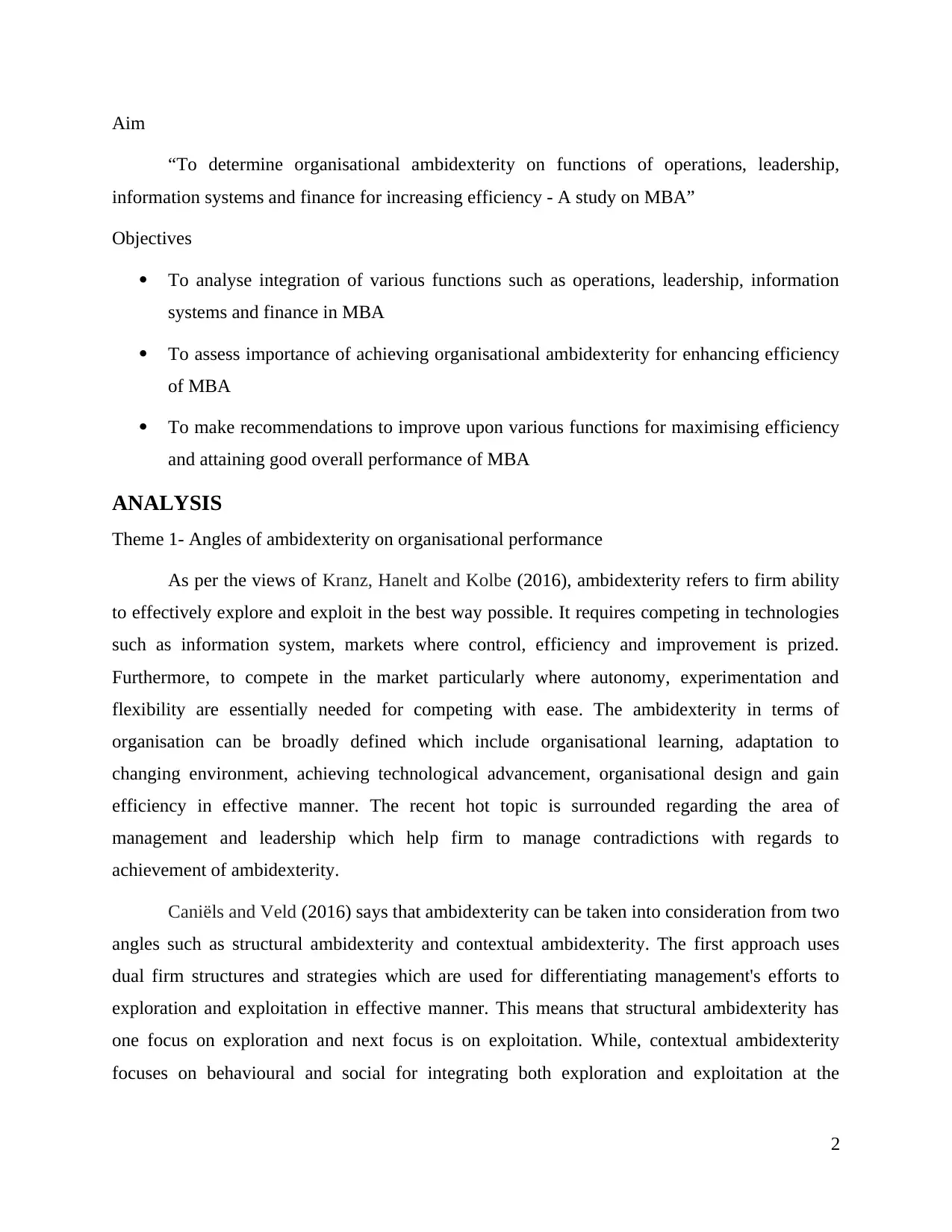
Aim
“To determine organisational ambidexterity on functions of operations, leadership,
information systems and finance for increasing efficiency - A study on MBA”
Objectives
To analyse integration of various functions such as operations, leadership, information
systems and finance in MBA
To assess importance of achieving organisational ambidexterity for enhancing efficiency
of MBA
To make recommendations to improve upon various functions for maximising efficiency
and attaining good overall performance of MBA
ANALYSIS
Theme 1- Angles of ambidexterity on organisational performance
As per the views of Kranz, Hanelt and Kolbe (2016), ambidexterity refers to firm ability
to effectively explore and exploit in the best way possible. It requires competing in technologies
such as information system, markets where control, efficiency and improvement is prized.
Furthermore, to compete in the market particularly where autonomy, experimentation and
flexibility are essentially needed for competing with ease. The ambidexterity in terms of
organisation can be broadly defined which include organisational learning, adaptation to
changing environment, achieving technological advancement, organisational design and gain
efficiency in effective manner. The recent hot topic is surrounded regarding the area of
management and leadership which help firm to manage contradictions with regards to
achievement of ambidexterity.
Caniëls and Veld (2016) says that ambidexterity can be taken into consideration from two
angles such as structural ambidexterity and contextual ambidexterity. The first approach uses
dual firm structures and strategies which are used for differentiating management's efforts to
exploration and exploitation in effective manner. This means that structural ambidexterity has
one focus on exploration and next focus is on exploitation. While, contextual ambidexterity
focuses on behavioural and social for integrating both exploration and exploitation at the
2
“To determine organisational ambidexterity on functions of operations, leadership,
information systems and finance for increasing efficiency - A study on MBA”
Objectives
To analyse integration of various functions such as operations, leadership, information
systems and finance in MBA
To assess importance of achieving organisational ambidexterity for enhancing efficiency
of MBA
To make recommendations to improve upon various functions for maximising efficiency
and attaining good overall performance of MBA
ANALYSIS
Theme 1- Angles of ambidexterity on organisational performance
As per the views of Kranz, Hanelt and Kolbe (2016), ambidexterity refers to firm ability
to effectively explore and exploit in the best way possible. It requires competing in technologies
such as information system, markets where control, efficiency and improvement is prized.
Furthermore, to compete in the market particularly where autonomy, experimentation and
flexibility are essentially needed for competing with ease. The ambidexterity in terms of
organisation can be broadly defined which include organisational learning, adaptation to
changing environment, achieving technological advancement, organisational design and gain
efficiency in effective manner. The recent hot topic is surrounded regarding the area of
management and leadership which help firm to manage contradictions with regards to
achievement of ambidexterity.
Caniëls and Veld (2016) says that ambidexterity can be taken into consideration from two
angles such as structural ambidexterity and contextual ambidexterity. The first approach uses
dual firm structures and strategies which are used for differentiating management's efforts to
exploration and exploitation in effective manner. This means that structural ambidexterity has
one focus on exploration and next focus is on exploitation. While, contextual ambidexterity
focuses on behavioural and social for integrating both exploration and exploitation at the
2
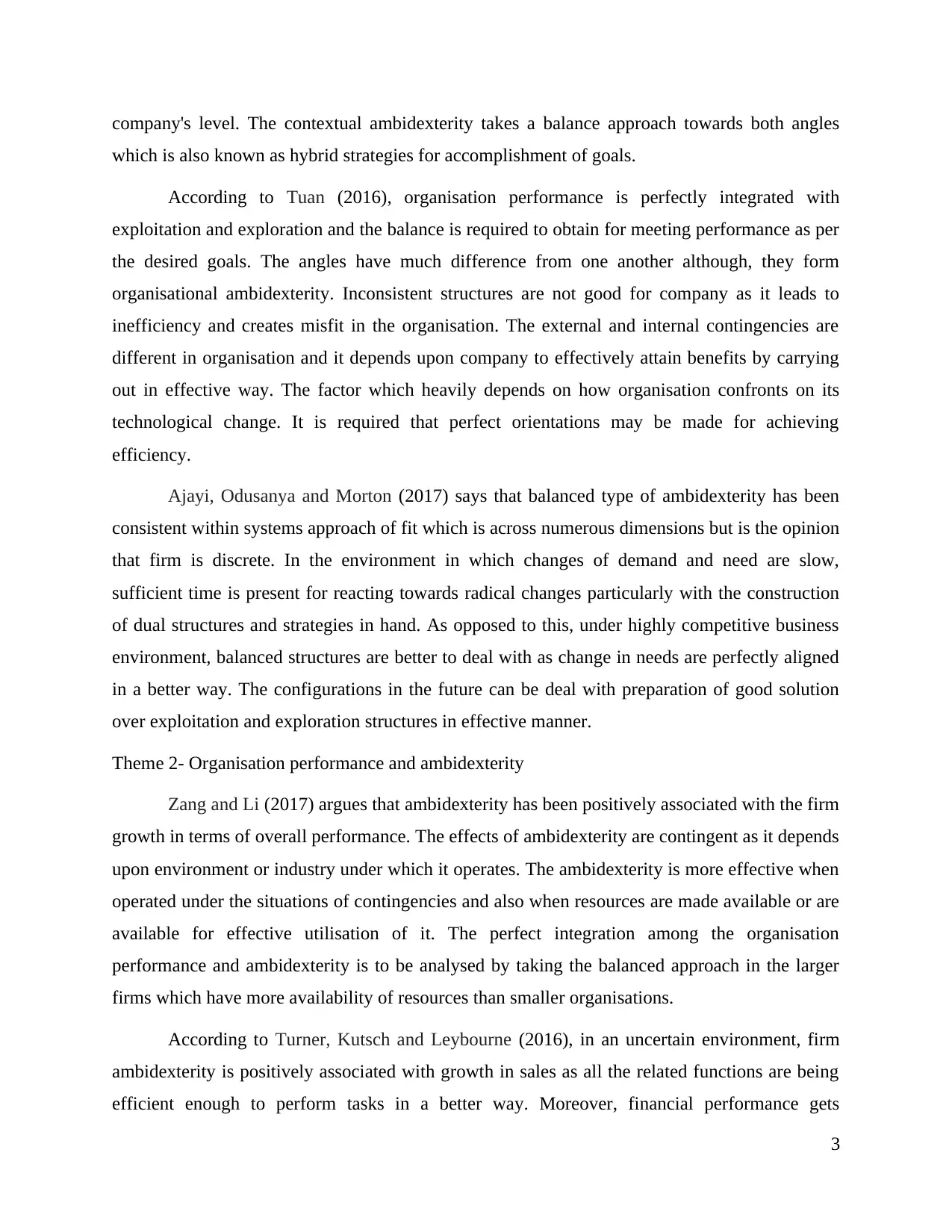
company's level. The contextual ambidexterity takes a balance approach towards both angles
which is also known as hybrid strategies for accomplishment of goals.
According to Tuan (2016), organisation performance is perfectly integrated with
exploitation and exploration and the balance is required to obtain for meeting performance as per
the desired goals. The angles have much difference from one another although, they form
organisational ambidexterity. Inconsistent structures are not good for company as it leads to
inefficiency and creates misfit in the organisation. The external and internal contingencies are
different in organisation and it depends upon company to effectively attain benefits by carrying
out in effective way. The factor which heavily depends on how organisation confronts on its
technological change. It is required that perfect orientations may be made for achieving
efficiency.
Ajayi, Odusanya and Morton (2017) says that balanced type of ambidexterity has been
consistent within systems approach of fit which is across numerous dimensions but is the opinion
that firm is discrete. In the environment in which changes of demand and need are slow,
sufficient time is present for reacting towards radical changes particularly with the construction
of dual structures and strategies in hand. As opposed to this, under highly competitive business
environment, balanced structures are better to deal with as change in needs are perfectly aligned
in a better way. The configurations in the future can be deal with preparation of good solution
over exploitation and exploration structures in effective manner.
Theme 2- Organisation performance and ambidexterity
Zang and Li (2017) argues that ambidexterity has been positively associated with the firm
growth in terms of overall performance. The effects of ambidexterity are contingent as it depends
upon environment or industry under which it operates. The ambidexterity is more effective when
operated under the situations of contingencies and also when resources are made available or are
available for effective utilisation of it. The perfect integration among the organisation
performance and ambidexterity is to be analysed by taking the balanced approach in the larger
firms which have more availability of resources than smaller organisations.
According to Turner, Kutsch and Leybourne (2016), in an uncertain environment, firm
ambidexterity is positively associated with growth in sales as all the related functions are being
efficient enough to perform tasks in a better way. Moreover, financial performance gets
3
which is also known as hybrid strategies for accomplishment of goals.
According to Tuan (2016), organisation performance is perfectly integrated with
exploitation and exploration and the balance is required to obtain for meeting performance as per
the desired goals. The angles have much difference from one another although, they form
organisational ambidexterity. Inconsistent structures are not good for company as it leads to
inefficiency and creates misfit in the organisation. The external and internal contingencies are
different in organisation and it depends upon company to effectively attain benefits by carrying
out in effective way. The factor which heavily depends on how organisation confronts on its
technological change. It is required that perfect orientations may be made for achieving
efficiency.
Ajayi, Odusanya and Morton (2017) says that balanced type of ambidexterity has been
consistent within systems approach of fit which is across numerous dimensions but is the opinion
that firm is discrete. In the environment in which changes of demand and need are slow,
sufficient time is present for reacting towards radical changes particularly with the construction
of dual structures and strategies in hand. As opposed to this, under highly competitive business
environment, balanced structures are better to deal with as change in needs are perfectly aligned
in a better way. The configurations in the future can be deal with preparation of good solution
over exploitation and exploration structures in effective manner.
Theme 2- Organisation performance and ambidexterity
Zang and Li (2017) argues that ambidexterity has been positively associated with the firm
growth in terms of overall performance. The effects of ambidexterity are contingent as it depends
upon environment or industry under which it operates. The ambidexterity is more effective when
operated under the situations of contingencies and also when resources are made available or are
available for effective utilisation of it. The perfect integration among the organisation
performance and ambidexterity is to be analysed by taking the balanced approach in the larger
firms which have more availability of resources than smaller organisations.
According to Turner, Kutsch and Leybourne (2016), in an uncertain environment, firm
ambidexterity is positively associated with growth in sales as all the related functions are being
efficient enough to perform tasks in a better way. Moreover, financial performance gets
3
⊘ This is a preview!⊘
Do you want full access?
Subscribe today to unlock all pages.

Trusted by 1+ million students worldwide
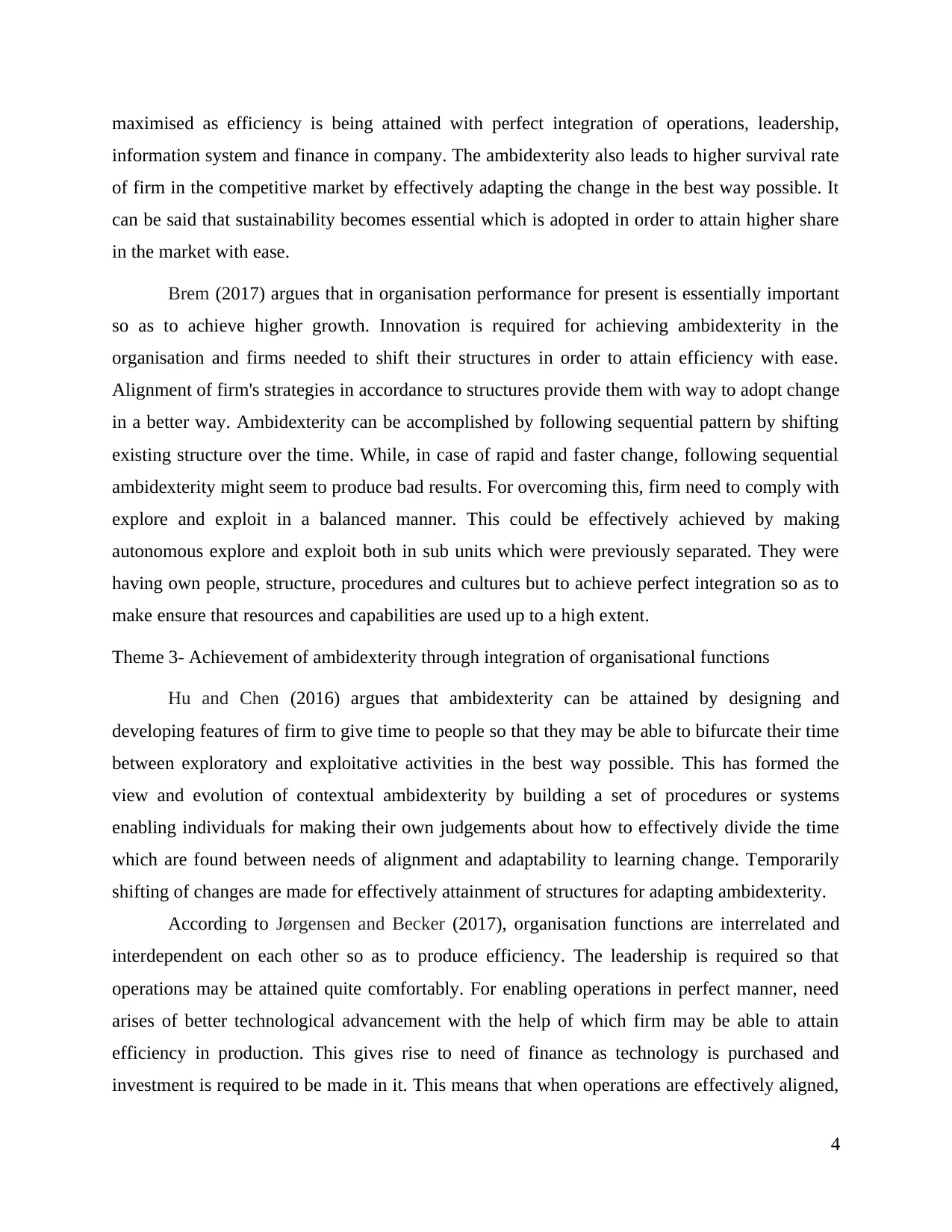
maximised as efficiency is being attained with perfect integration of operations, leadership,
information system and finance in company. The ambidexterity also leads to higher survival rate
of firm in the competitive market by effectively adapting the change in the best way possible. It
can be said that sustainability becomes essential which is adopted in order to attain higher share
in the market with ease.
Brem (2017) argues that in organisation performance for present is essentially important
so as to achieve higher growth. Innovation is required for achieving ambidexterity in the
organisation and firms needed to shift their structures in order to attain efficiency with ease.
Alignment of firm's strategies in accordance to structures provide them with way to adopt change
in a better way. Ambidexterity can be accomplished by following sequential pattern by shifting
existing structure over the time. While, in case of rapid and faster change, following sequential
ambidexterity might seem to produce bad results. For overcoming this, firm need to comply with
explore and exploit in a balanced manner. This could be effectively achieved by making
autonomous explore and exploit both in sub units which were previously separated. They were
having own people, structure, procedures and cultures but to achieve perfect integration so as to
make ensure that resources and capabilities are used up to a high extent.
Theme 3- Achievement of ambidexterity through integration of organisational functions
Hu and Chen (2016) argues that ambidexterity can be attained by designing and
developing features of firm to give time to people so that they may be able to bifurcate their time
between exploratory and exploitative activities in the best way possible. This has formed the
view and evolution of contextual ambidexterity by building a set of procedures or systems
enabling individuals for making their own judgements about how to effectively divide the time
which are found between needs of alignment and adaptability to learning change. Temporarily
shifting of changes are made for effectively attainment of structures for adapting ambidexterity.
According to Jørgensen and Becker (2017), organisation functions are interrelated and
interdependent on each other so as to produce efficiency. The leadership is required so that
operations may be attained quite comfortably. For enabling operations in perfect manner, need
arises of better technological advancement with the help of which firm may be able to attain
efficiency in production. This gives rise to need of finance as technology is purchased and
investment is required to be made in it. This means that when operations are effectively aligned,
4
information system and finance in company. The ambidexterity also leads to higher survival rate
of firm in the competitive market by effectively adapting the change in the best way possible. It
can be said that sustainability becomes essential which is adopted in order to attain higher share
in the market with ease.
Brem (2017) argues that in organisation performance for present is essentially important
so as to achieve higher growth. Innovation is required for achieving ambidexterity in the
organisation and firms needed to shift their structures in order to attain efficiency with ease.
Alignment of firm's strategies in accordance to structures provide them with way to adopt change
in a better way. Ambidexterity can be accomplished by following sequential pattern by shifting
existing structure over the time. While, in case of rapid and faster change, following sequential
ambidexterity might seem to produce bad results. For overcoming this, firm need to comply with
explore and exploit in a balanced manner. This could be effectively achieved by making
autonomous explore and exploit both in sub units which were previously separated. They were
having own people, structure, procedures and cultures but to achieve perfect integration so as to
make ensure that resources and capabilities are used up to a high extent.
Theme 3- Achievement of ambidexterity through integration of organisational functions
Hu and Chen (2016) argues that ambidexterity can be attained by designing and
developing features of firm to give time to people so that they may be able to bifurcate their time
between exploratory and exploitative activities in the best way possible. This has formed the
view and evolution of contextual ambidexterity by building a set of procedures or systems
enabling individuals for making their own judgements about how to effectively divide the time
which are found between needs of alignment and adaptability to learning change. Temporarily
shifting of changes are made for effectively attainment of structures for adapting ambidexterity.
According to Jørgensen and Becker (2017), organisation functions are interrelated and
interdependent on each other so as to produce efficiency. The leadership is required so that
operations may be attained quite comfortably. For enabling operations in perfect manner, need
arises of better technological advancement with the help of which firm may be able to attain
efficiency in production. This gives rise to need of finance as technology is purchased and
investment is required to be made in it. This means that when operations are effectively aligned,
4
Paraphrase This Document
Need a fresh take? Get an instant paraphrase of this document with our AI Paraphraser
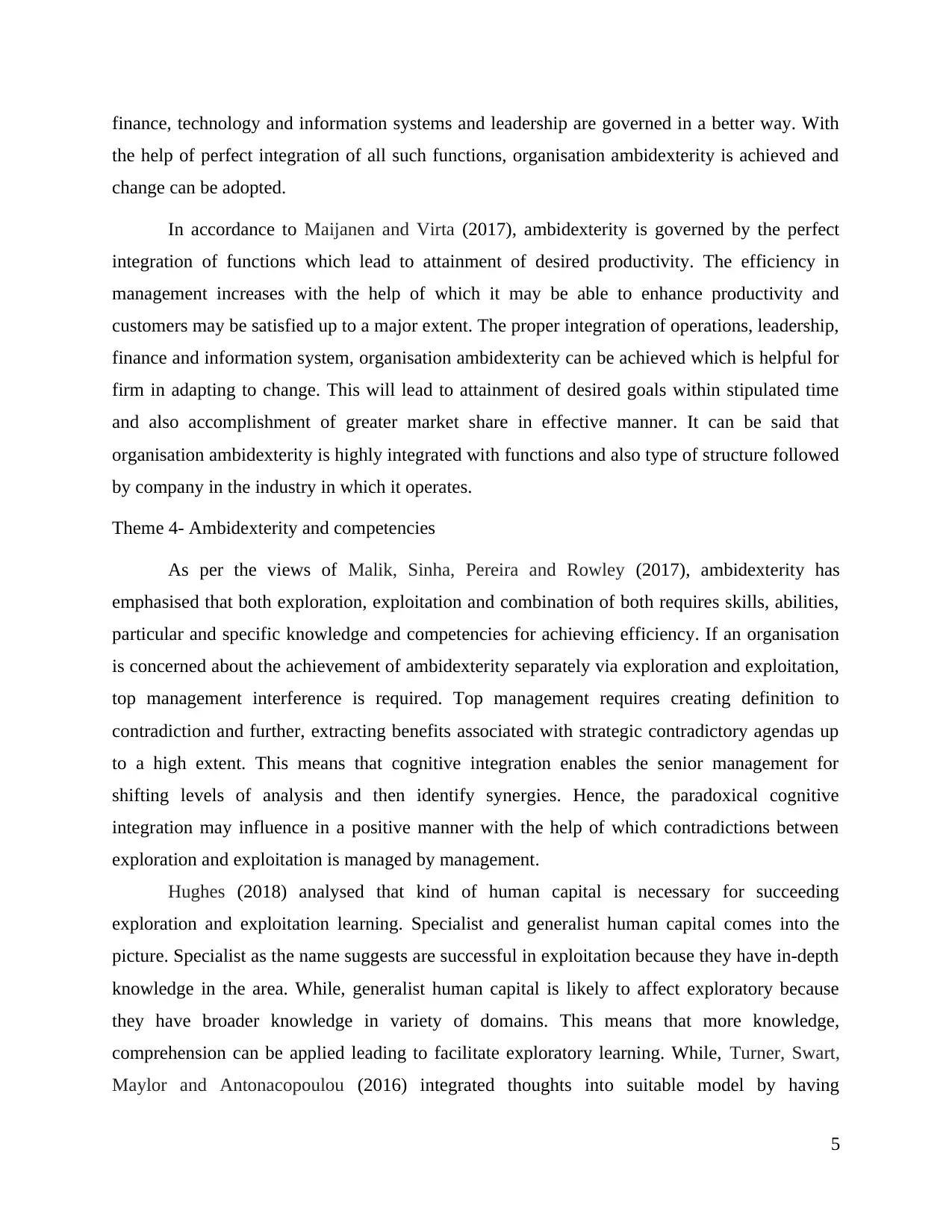
finance, technology and information systems and leadership are governed in a better way. With
the help of perfect integration of all such functions, organisation ambidexterity is achieved and
change can be adopted.
In accordance to Maijanen and Virta (2017), ambidexterity is governed by the perfect
integration of functions which lead to attainment of desired productivity. The efficiency in
management increases with the help of which it may be able to enhance productivity and
customers may be satisfied up to a major extent. The proper integration of operations, leadership,
finance and information system, organisation ambidexterity can be achieved which is helpful for
firm in adapting to change. This will lead to attainment of desired goals within stipulated time
and also accomplishment of greater market share in effective manner. It can be said that
organisation ambidexterity is highly integrated with functions and also type of structure followed
by company in the industry in which it operates.
Theme 4- Ambidexterity and competencies
As per the views of Malik, Sinha, Pereira and Rowley (2017), ambidexterity has
emphasised that both exploration, exploitation and combination of both requires skills, abilities,
particular and specific knowledge and competencies for achieving efficiency. If an organisation
is concerned about the achievement of ambidexterity separately via exploration and exploitation,
top management interference is required. Top management requires creating definition to
contradiction and further, extracting benefits associated with strategic contradictory agendas up
to a high extent. This means that cognitive integration enables the senior management for
shifting levels of analysis and then identify synergies. Hence, the paradoxical cognitive
integration may influence in a positive manner with the help of which contradictions between
exploration and exploitation is managed by management.
Hughes (2018) analysed that kind of human capital is necessary for succeeding
exploration and exploitation learning. Specialist and generalist human capital comes into the
picture. Specialist as the name suggests are successful in exploitation because they have in-depth
knowledge in the area. While, generalist human capital is likely to affect exploratory because
they have broader knowledge in variety of domains. This means that more knowledge,
comprehension can be applied leading to facilitate exploratory learning. While, Turner, Swart,
Maylor and Antonacopoulou (2016) integrated thoughts into suitable model by having
5
the help of perfect integration of all such functions, organisation ambidexterity is achieved and
change can be adopted.
In accordance to Maijanen and Virta (2017), ambidexterity is governed by the perfect
integration of functions which lead to attainment of desired productivity. The efficiency in
management increases with the help of which it may be able to enhance productivity and
customers may be satisfied up to a major extent. The proper integration of operations, leadership,
finance and information system, organisation ambidexterity can be achieved which is helpful for
firm in adapting to change. This will lead to attainment of desired goals within stipulated time
and also accomplishment of greater market share in effective manner. It can be said that
organisation ambidexterity is highly integrated with functions and also type of structure followed
by company in the industry in which it operates.
Theme 4- Ambidexterity and competencies
As per the views of Malik, Sinha, Pereira and Rowley (2017), ambidexterity has
emphasised that both exploration, exploitation and combination of both requires skills, abilities,
particular and specific knowledge and competencies for achieving efficiency. If an organisation
is concerned about the achievement of ambidexterity separately via exploration and exploitation,
top management interference is required. Top management requires creating definition to
contradiction and further, extracting benefits associated with strategic contradictory agendas up
to a high extent. This means that cognitive integration enables the senior management for
shifting levels of analysis and then identify synergies. Hence, the paradoxical cognitive
integration may influence in a positive manner with the help of which contradictions between
exploration and exploitation is managed by management.
Hughes (2018) analysed that kind of human capital is necessary for succeeding
exploration and exploitation learning. Specialist and generalist human capital comes into the
picture. Specialist as the name suggests are successful in exploitation because they have in-depth
knowledge in the area. While, generalist human capital is likely to affect exploratory because
they have broader knowledge in variety of domains. This means that more knowledge,
comprehension can be applied leading to facilitate exploratory learning. While, Turner, Swart,
Maylor and Antonacopoulou (2016) integrated thoughts into suitable model by having
5
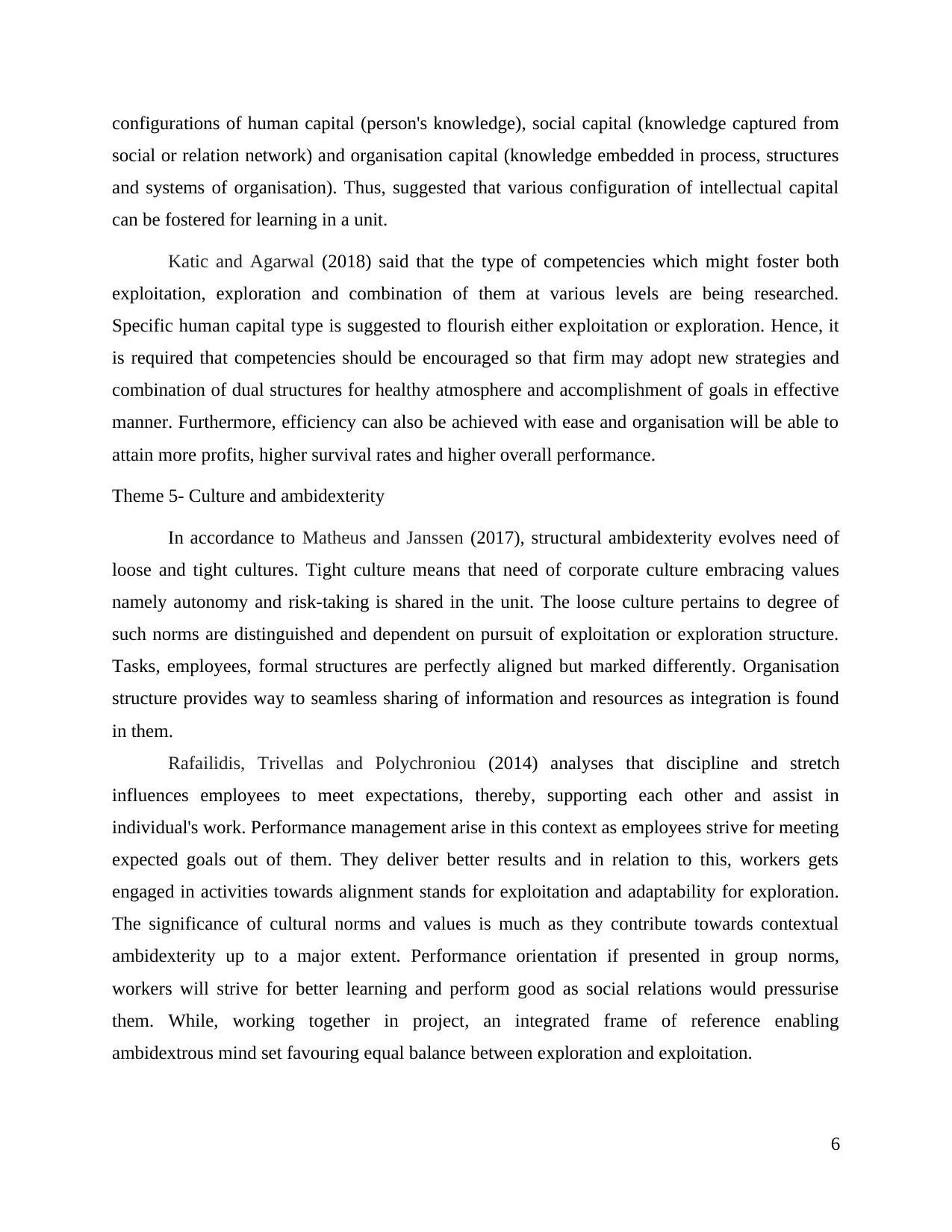
configurations of human capital (person's knowledge), social capital (knowledge captured from
social or relation network) and organisation capital (knowledge embedded in process, structures
and systems of organisation). Thus, suggested that various configuration of intellectual capital
can be fostered for learning in a unit.
Katic and Agarwal (2018) said that the type of competencies which might foster both
exploitation, exploration and combination of them at various levels are being researched.
Specific human capital type is suggested to flourish either exploitation or exploration. Hence, it
is required that competencies should be encouraged so that firm may adopt new strategies and
combination of dual structures for healthy atmosphere and accomplishment of goals in effective
manner. Furthermore, efficiency can also be achieved with ease and organisation will be able to
attain more profits, higher survival rates and higher overall performance.
Theme 5- Culture and ambidexterity
In accordance to Matheus and Janssen (2017), structural ambidexterity evolves need of
loose and tight cultures. Tight culture means that need of corporate culture embracing values
namely autonomy and risk-taking is shared in the unit. The loose culture pertains to degree of
such norms are distinguished and dependent on pursuit of exploitation or exploration structure.
Tasks, employees, formal structures are perfectly aligned but marked differently. Organisation
structure provides way to seamless sharing of information and resources as integration is found
in them.
Rafailidis, Trivellas and Polychroniou (2014) analyses that discipline and stretch
influences employees to meet expectations, thereby, supporting each other and assist in
individual's work. Performance management arise in this context as employees strive for meeting
expected goals out of them. They deliver better results and in relation to this, workers gets
engaged in activities towards alignment stands for exploitation and adaptability for exploration.
The significance of cultural norms and values is much as they contribute towards contextual
ambidexterity up to a major extent. Performance orientation if presented in group norms,
workers will strive for better learning and perform good as social relations would pressurise
them. While, working together in project, an integrated frame of reference enabling
ambidextrous mind set favouring equal balance between exploration and exploitation.
6
social or relation network) and organisation capital (knowledge embedded in process, structures
and systems of organisation). Thus, suggested that various configuration of intellectual capital
can be fostered for learning in a unit.
Katic and Agarwal (2018) said that the type of competencies which might foster both
exploitation, exploration and combination of them at various levels are being researched.
Specific human capital type is suggested to flourish either exploitation or exploration. Hence, it
is required that competencies should be encouraged so that firm may adopt new strategies and
combination of dual structures for healthy atmosphere and accomplishment of goals in effective
manner. Furthermore, efficiency can also be achieved with ease and organisation will be able to
attain more profits, higher survival rates and higher overall performance.
Theme 5- Culture and ambidexterity
In accordance to Matheus and Janssen (2017), structural ambidexterity evolves need of
loose and tight cultures. Tight culture means that need of corporate culture embracing values
namely autonomy and risk-taking is shared in the unit. The loose culture pertains to degree of
such norms are distinguished and dependent on pursuit of exploitation or exploration structure.
Tasks, employees, formal structures are perfectly aligned but marked differently. Organisation
structure provides way to seamless sharing of information and resources as integration is found
in them.
Rafailidis, Trivellas and Polychroniou (2014) analyses that discipline and stretch
influences employees to meet expectations, thereby, supporting each other and assist in
individual's work. Performance management arise in this context as employees strive for meeting
expected goals out of them. They deliver better results and in relation to this, workers gets
engaged in activities towards alignment stands for exploitation and adaptability for exploration.
The significance of cultural norms and values is much as they contribute towards contextual
ambidexterity up to a major extent. Performance orientation if presented in group norms,
workers will strive for better learning and perform good as social relations would pressurise
them. While, working together in project, an integrated frame of reference enabling
ambidextrous mind set favouring equal balance between exploration and exploitation.
6
⊘ This is a preview!⊘
Do you want full access?
Subscribe today to unlock all pages.

Trusted by 1+ million students worldwide
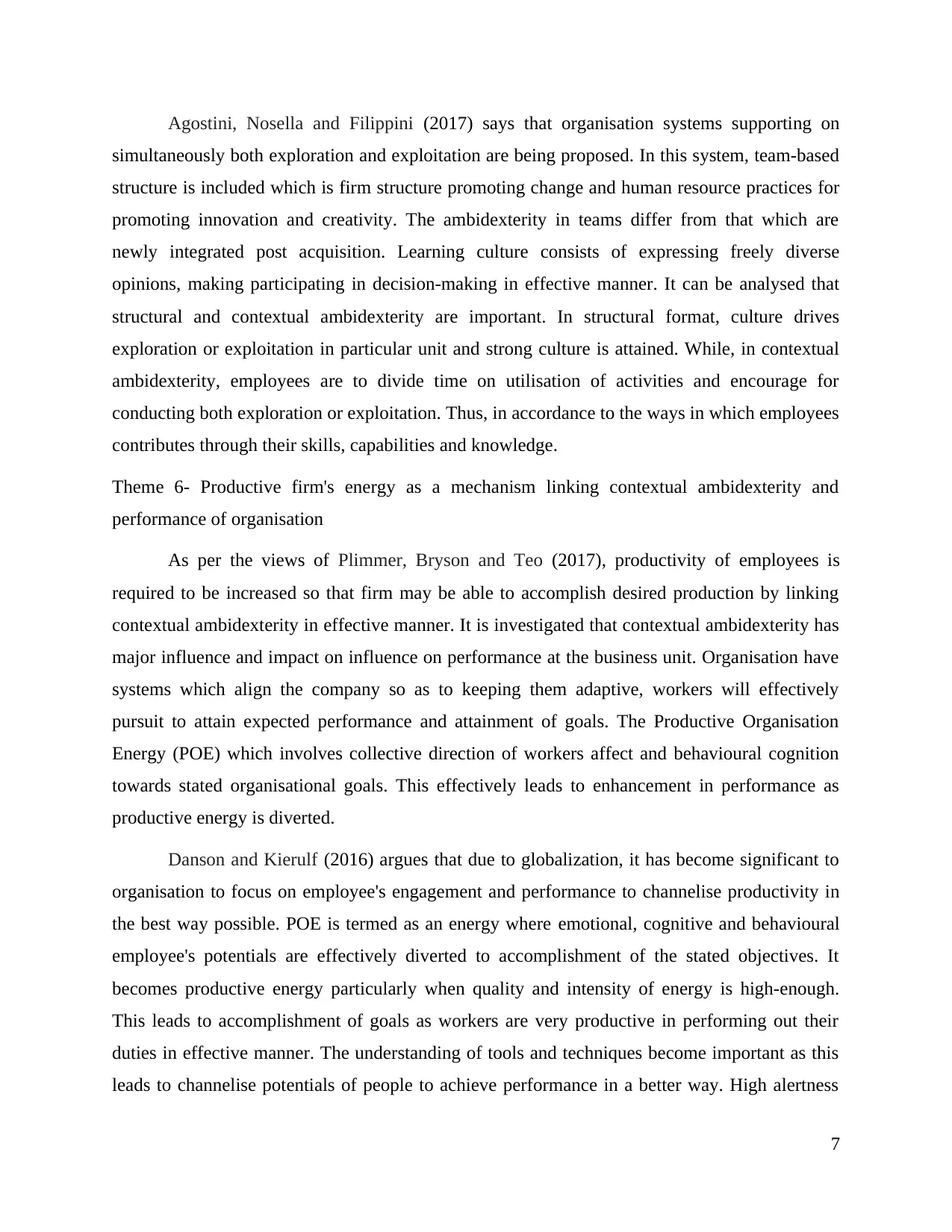
Agostini, Nosella and Filippini (2017) says that organisation systems supporting on
simultaneously both exploration and exploitation are being proposed. In this system, team-based
structure is included which is firm structure promoting change and human resource practices for
promoting innovation and creativity. The ambidexterity in teams differ from that which are
newly integrated post acquisition. Learning culture consists of expressing freely diverse
opinions, making participating in decision-making in effective manner. It can be analysed that
structural and contextual ambidexterity are important. In structural format, culture drives
exploration or exploitation in particular unit and strong culture is attained. While, in contextual
ambidexterity, employees are to divide time on utilisation of activities and encourage for
conducting both exploration or exploitation. Thus, in accordance to the ways in which employees
contributes through their skills, capabilities and knowledge.
Theme 6- Productive firm's energy as a mechanism linking contextual ambidexterity and
performance of organisation
As per the views of Plimmer, Bryson and Teo (2017), productivity of employees is
required to be increased so that firm may be able to accomplish desired production by linking
contextual ambidexterity in effective manner. It is investigated that contextual ambidexterity has
major influence and impact on influence on performance at the business unit. Organisation have
systems which align the company so as to keeping them adaptive, workers will effectively
pursuit to attain expected performance and attainment of goals. The Productive Organisation
Energy (POE) which involves collective direction of workers affect and behavioural cognition
towards stated organisational goals. This effectively leads to enhancement in performance as
productive energy is diverted.
Danson and Kierulf (2016) argues that due to globalization, it has become significant to
organisation to focus on employee's engagement and performance to channelise productivity in
the best way possible. POE is termed as an energy where emotional, cognitive and behavioural
employee's potentials are effectively diverted to accomplishment of the stated objectives. It
becomes productive energy particularly when quality and intensity of energy is high-enough.
This leads to accomplishment of goals as workers are very productive in performing out their
duties in effective manner. The understanding of tools and techniques become important as this
leads to channelise potentials of people to achieve performance in a better way. High alertness
7
simultaneously both exploration and exploitation are being proposed. In this system, team-based
structure is included which is firm structure promoting change and human resource practices for
promoting innovation and creativity. The ambidexterity in teams differ from that which are
newly integrated post acquisition. Learning culture consists of expressing freely diverse
opinions, making participating in decision-making in effective manner. It can be analysed that
structural and contextual ambidexterity are important. In structural format, culture drives
exploration or exploitation in particular unit and strong culture is attained. While, in contextual
ambidexterity, employees are to divide time on utilisation of activities and encourage for
conducting both exploration or exploitation. Thus, in accordance to the ways in which employees
contributes through their skills, capabilities and knowledge.
Theme 6- Productive firm's energy as a mechanism linking contextual ambidexterity and
performance of organisation
As per the views of Plimmer, Bryson and Teo (2017), productivity of employees is
required to be increased so that firm may be able to accomplish desired production by linking
contextual ambidexterity in effective manner. It is investigated that contextual ambidexterity has
major influence and impact on influence on performance at the business unit. Organisation have
systems which align the company so as to keeping them adaptive, workers will effectively
pursuit to attain expected performance and attainment of goals. The Productive Organisation
Energy (POE) which involves collective direction of workers affect and behavioural cognition
towards stated organisational goals. This effectively leads to enhancement in performance as
productive energy is diverted.
Danson and Kierulf (2016) argues that due to globalization, it has become significant to
organisation to focus on employee's engagement and performance to channelise productivity in
the best way possible. POE is termed as an energy where emotional, cognitive and behavioural
employee's potentials are effectively diverted to accomplishment of the stated objectives. It
becomes productive energy particularly when quality and intensity of energy is high-enough.
This leads to accomplishment of goals as workers are very productive in performing out their
duties in effective manner. The understanding of tools and techniques become important as this
leads to channelise potentials of people to achieve performance in a better way. High alertness
7
Paraphrase This Document
Need a fresh take? Get an instant paraphrase of this document with our AI Paraphraser
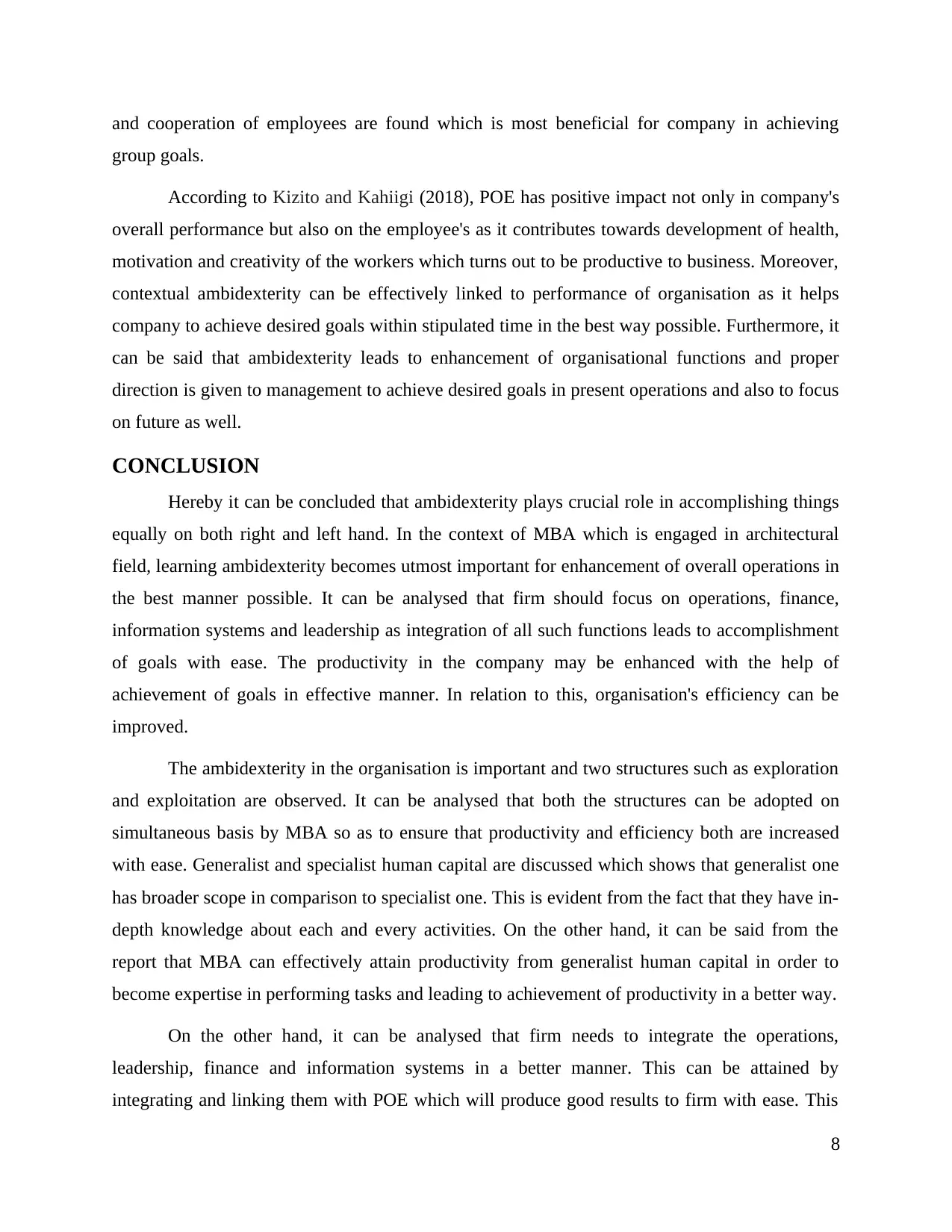
and cooperation of employees are found which is most beneficial for company in achieving
group goals.
According to Kizito and Kahiigi (2018), POE has positive impact not only in company's
overall performance but also on the employee's as it contributes towards development of health,
motivation and creativity of the workers which turns out to be productive to business. Moreover,
contextual ambidexterity can be effectively linked to performance of organisation as it helps
company to achieve desired goals within stipulated time in the best way possible. Furthermore, it
can be said that ambidexterity leads to enhancement of organisational functions and proper
direction is given to management to achieve desired goals in present operations and also to focus
on future as well.
CONCLUSION
Hereby it can be concluded that ambidexterity plays crucial role in accomplishing things
equally on both right and left hand. In the context of MBA which is engaged in architectural
field, learning ambidexterity becomes utmost important for enhancement of overall operations in
the best manner possible. It can be analysed that firm should focus on operations, finance,
information systems and leadership as integration of all such functions leads to accomplishment
of goals with ease. The productivity in the company may be enhanced with the help of
achievement of goals in effective manner. In relation to this, organisation's efficiency can be
improved.
The ambidexterity in the organisation is important and two structures such as exploration
and exploitation are observed. It can be analysed that both the structures can be adopted on
simultaneous basis by MBA so as to ensure that productivity and efficiency both are increased
with ease. Generalist and specialist human capital are discussed which shows that generalist one
has broader scope in comparison to specialist one. This is evident from the fact that they have in-
depth knowledge about each and every activities. On the other hand, it can be said from the
report that MBA can effectively attain productivity from generalist human capital in order to
become expertise in performing tasks and leading to achievement of productivity in a better way.
On the other hand, it can be analysed that firm needs to integrate the operations,
leadership, finance and information systems in a better manner. This can be attained by
integrating and linking them with POE which will produce good results to firm with ease. This
8
group goals.
According to Kizito and Kahiigi (2018), POE has positive impact not only in company's
overall performance but also on the employee's as it contributes towards development of health,
motivation and creativity of the workers which turns out to be productive to business. Moreover,
contextual ambidexterity can be effectively linked to performance of organisation as it helps
company to achieve desired goals within stipulated time in the best way possible. Furthermore, it
can be said that ambidexterity leads to enhancement of organisational functions and proper
direction is given to management to achieve desired goals in present operations and also to focus
on future as well.
CONCLUSION
Hereby it can be concluded that ambidexterity plays crucial role in accomplishing things
equally on both right and left hand. In the context of MBA which is engaged in architectural
field, learning ambidexterity becomes utmost important for enhancement of overall operations in
the best manner possible. It can be analysed that firm should focus on operations, finance,
information systems and leadership as integration of all such functions leads to accomplishment
of goals with ease. The productivity in the company may be enhanced with the help of
achievement of goals in effective manner. In relation to this, organisation's efficiency can be
improved.
The ambidexterity in the organisation is important and two structures such as exploration
and exploitation are observed. It can be analysed that both the structures can be adopted on
simultaneous basis by MBA so as to ensure that productivity and efficiency both are increased
with ease. Generalist and specialist human capital are discussed which shows that generalist one
has broader scope in comparison to specialist one. This is evident from the fact that they have in-
depth knowledge about each and every activities. On the other hand, it can be said from the
report that MBA can effectively attain productivity from generalist human capital in order to
become expertise in performing tasks and leading to achievement of productivity in a better way.
On the other hand, it can be analysed that firm needs to integrate the operations,
leadership, finance and information systems in a better manner. This can be attained by
integrating and linking them with POE which will produce good results to firm with ease. This
8
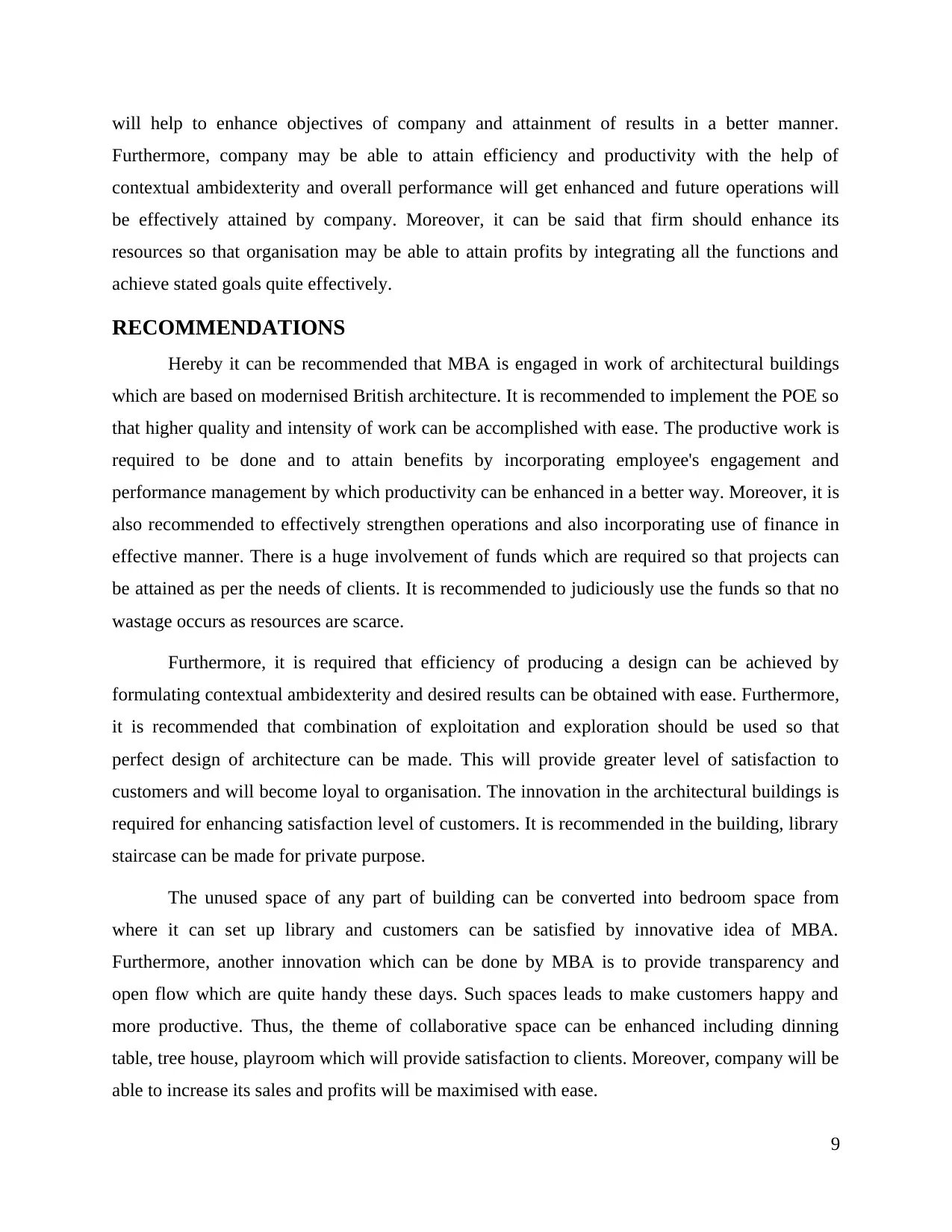
will help to enhance objectives of company and attainment of results in a better manner.
Furthermore, company may be able to attain efficiency and productivity with the help of
contextual ambidexterity and overall performance will get enhanced and future operations will
be effectively attained by company. Moreover, it can be said that firm should enhance its
resources so that organisation may be able to attain profits by integrating all the functions and
achieve stated goals quite effectively.
RECOMMENDATIONS
Hereby it can be recommended that MBA is engaged in work of architectural buildings
which are based on modernised British architecture. It is recommended to implement the POE so
that higher quality and intensity of work can be accomplished with ease. The productive work is
required to be done and to attain benefits by incorporating employee's engagement and
performance management by which productivity can be enhanced in a better way. Moreover, it is
also recommended to effectively strengthen operations and also incorporating use of finance in
effective manner. There is a huge involvement of funds which are required so that projects can
be attained as per the needs of clients. It is recommended to judiciously use the funds so that no
wastage occurs as resources are scarce.
Furthermore, it is required that efficiency of producing a design can be achieved by
formulating contextual ambidexterity and desired results can be obtained with ease. Furthermore,
it is recommended that combination of exploitation and exploration should be used so that
perfect design of architecture can be made. This will provide greater level of satisfaction to
customers and will become loyal to organisation. The innovation in the architectural buildings is
required for enhancing satisfaction level of customers. It is recommended in the building, library
staircase can be made for private purpose.
The unused space of any part of building can be converted into bedroom space from
where it can set up library and customers can be satisfied by innovative idea of MBA.
Furthermore, another innovation which can be done by MBA is to provide transparency and
open flow which are quite handy these days. Such spaces leads to make customers happy and
more productive. Thus, the theme of collaborative space can be enhanced including dinning
table, tree house, playroom which will provide satisfaction to clients. Moreover, company will be
able to increase its sales and profits will be maximised with ease.
9
Furthermore, company may be able to attain efficiency and productivity with the help of
contextual ambidexterity and overall performance will get enhanced and future operations will
be effectively attained by company. Moreover, it can be said that firm should enhance its
resources so that organisation may be able to attain profits by integrating all the functions and
achieve stated goals quite effectively.
RECOMMENDATIONS
Hereby it can be recommended that MBA is engaged in work of architectural buildings
which are based on modernised British architecture. It is recommended to implement the POE so
that higher quality and intensity of work can be accomplished with ease. The productive work is
required to be done and to attain benefits by incorporating employee's engagement and
performance management by which productivity can be enhanced in a better way. Moreover, it is
also recommended to effectively strengthen operations and also incorporating use of finance in
effective manner. There is a huge involvement of funds which are required so that projects can
be attained as per the needs of clients. It is recommended to judiciously use the funds so that no
wastage occurs as resources are scarce.
Furthermore, it is required that efficiency of producing a design can be achieved by
formulating contextual ambidexterity and desired results can be obtained with ease. Furthermore,
it is recommended that combination of exploitation and exploration should be used so that
perfect design of architecture can be made. This will provide greater level of satisfaction to
customers and will become loyal to organisation. The innovation in the architectural buildings is
required for enhancing satisfaction level of customers. It is recommended in the building, library
staircase can be made for private purpose.
The unused space of any part of building can be converted into bedroom space from
where it can set up library and customers can be satisfied by innovative idea of MBA.
Furthermore, another innovation which can be done by MBA is to provide transparency and
open flow which are quite handy these days. Such spaces leads to make customers happy and
more productive. Thus, the theme of collaborative space can be enhanced including dinning
table, tree house, playroom which will provide satisfaction to clients. Moreover, company will be
able to increase its sales and profits will be maximised with ease.
9
⊘ This is a preview!⊘
Do you want full access?
Subscribe today to unlock all pages.

Trusted by 1+ million students worldwide
1 out of 15
Related Documents
Your All-in-One AI-Powered Toolkit for Academic Success.
+13062052269
info@desklib.com
Available 24*7 on WhatsApp / Email
![[object Object]](/_next/static/media/star-bottom.7253800d.svg)
Unlock your academic potential
Copyright © 2020–2025 A2Z Services. All Rights Reserved. Developed and managed by ZUCOL.





